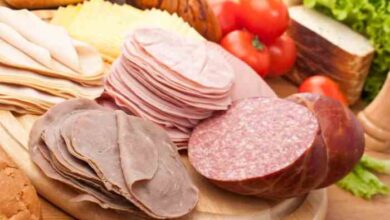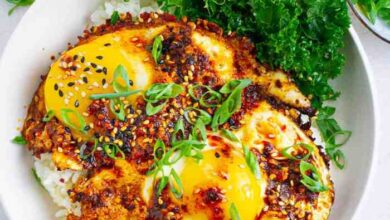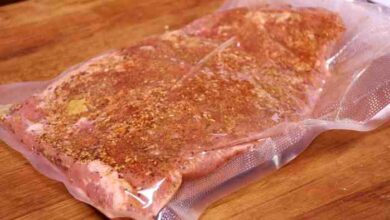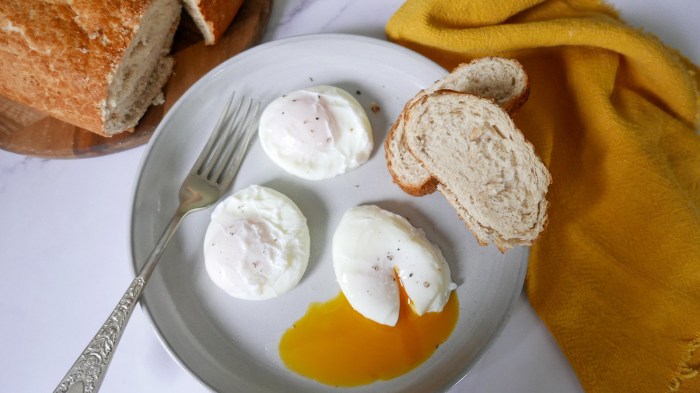
Sous Vide Poached Eggs: Perfect Every Time
Sous vide poached eggs are a game-changer for breakfast enthusiasts, offering a level of precision and control that traditional poaching methods simply can’t match. This technique, which involves immersing eggs in a precisely temperature-controlled water bath, guarantees perfectly cooked yolks and whites every time.
No more runny whites or rubbery yolks!
Whether you’re a seasoned chef or a kitchen novice, sous vide poaching is surprisingly easy to master. With a few essential tools and a bit of practice, you’ll be wowing your friends and family with restaurant-quality poached eggs in no time.
What is Sous Vide Poaching?
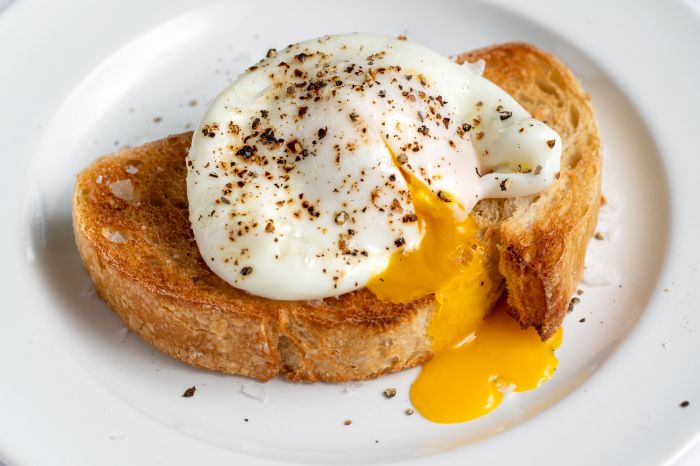
Sous vide poaching is a technique that involves cooking food, specifically eggs in this case, in a water bath at a precisely controlled temperature. This method ensures even cooking and prevents overcooking, resulting in perfectly cooked eggs with a creamy, runny yolk and a tender, set white.
Comparison with Traditional Poaching Methods
Traditional poaching methods often involve simmering eggs in a pot of water, which can lead to inconsistent results due to variations in water temperature and the difficulty in controlling the heat.
- Sous vide poaching offers greater control over the cooking process, ensuring consistent results every time.
- The precise temperature control in sous vide eliminates the risk of overcooked whites or a rubbery yolk, which can happen with traditional poaching.
- Sous vide poaching also allows for more flexibility in cooking time, as the eggs can be cooked for longer periods without overcooking.
Benefits of Sous Vide Poaching
Sous vide poaching offers several advantages over traditional poaching methods.
- Consistent Results:Sous vide poaching provides precise temperature control, ensuring that each egg is cooked to the same degree of doneness.
- Perfect Texture:The even cooking of sous vide results in a tender, set white and a creamy, runny yolk, ideal for many dishes.
- Flexibility:Sous vide allows for greater flexibility in cooking time, enabling you to cook eggs for longer periods without overcooking.
- Hands-Off Cooking:Once the eggs are submerged in the water bath, they require minimal attention, allowing you to focus on other tasks.
Drawbacks of Sous Vide Poaching
While sous vide poaching offers numerous benefits, it also has some drawbacks.
- Equipment:Sous vide poaching requires a specialized piece of equipment, a sous vide immersion circulator, which can be a significant investment for some.
- Time:Sous vide poaching generally takes longer than traditional poaching methods, as the eggs need to be cooked at a lower temperature for an extended period.
- Cleanup:Cleaning the sous vide immersion circulator and the water bath can be slightly more involved than cleaning traditional poaching equipment.
Equipment and Supplies
Sous vide poaching requires a few essential pieces of equipment and supplies. This setup allows for precise temperature control and ensures perfectly cooked eggs.
Let’s take a look at the necessary equipment and supplies for a successful sous vide poached egg experience.
Sous vide poached eggs are a game-changer for breakfast. They’re perfectly cooked, with a creamy yolk and a tender white. I love to pair them with a dollop of spicy salami spread nduja for a touch of heat and richness.
The nduja adds a smoky, savory flavor that contrasts beautifully with the delicate eggs. It’s a simple but satisfying combination that’s sure to impress.
Sous Vide Immersion Circulator
Sous vide immersion circulators are the heart of the sous vide cooking process. They are devices that heat a water bath to a precise temperature and maintain it consistently.
Immersion circulators come in various sizes and features, catering to different needs and budgets. Here’s a breakdown of some popular types:
- Basic Immersion Circulator:These are entry-level models with essential features like temperature control and a timer. They are suitable for smaller water baths and occasional use. For instance, the Joule by ChefSteps is a compact and powerful immersion circulator that is popular among home cooks.
- Advanced Immersion Circulator:These models offer additional features like WiFi connectivity, smartphone app control, and advanced temperature control options. They are ideal for serious cooks who want to explore the full potential of sous vide cooking. For example, the Anova Precision Cooker is a popular choice for its advanced features and reliable performance.
Sous vide poached eggs are a game-changer for breakfast, giving you perfectly cooked yolks every time. But what about the rest of the meal? A light and refreshing side like the three bean salad ii adds a burst of flavor and texture, complementing the rich, creamy eggs beautifully.
Just remember to chill the salad for a bit before serving to ensure it’s nice and cool against the warm, runny yolk.
- Commercial-Grade Immersion Circulator:These are high-performance circulators designed for professional kitchens. They offer features like large capacity, high-power output, and robust construction. For example, the PolyScience Professional Series circulator is known for its exceptional performance and durability.
Container for Poaching
The container you choose for sous vide poaching will determine the size and quantity of eggs you can cook at once.
Here are some factors to consider when choosing a container:
- Size:Choose a container that is large enough to hold the immersion circulator and enough water to fully submerge the eggs. A container with a capacity of at least 2-3 gallons is recommended for a standard batch of eggs.
- Material:Stainless steel or heat-resistant plastic containers are ideal for sous vide poaching. Avoid using containers made of glass or other materials that may crack or break when exposed to high temperatures.
- Shape:A rectangular or square container is preferred as it allows for more efficient use of space and even heat distribution. A round container can also work, but you may need to adjust the water level to ensure proper immersion of the eggs.
Techniques and Procedures: Sous Vide Poached Eggs
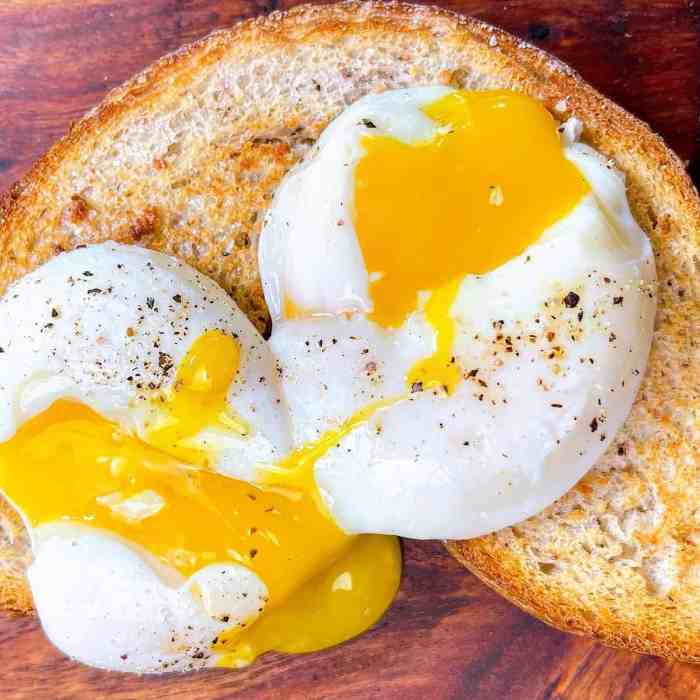
Sous vide poaching eggs is a simple process that requires precise temperature control and careful timing. This technique offers a remarkable level of control over the egg’s doneness, resulting in perfectly cooked eggs with a creamy, velvety yolk and a tender, set white.
Let’s explore the steps involved in this culinary technique.
Sous vide poached eggs are a game-changer for breakfast, offering perfectly cooked yolks every time. And while the eggs are simmering, why not whip up a bowl of steaming miso soup with shiitake mushrooms ? The umami-rich broth complements the creamy eggs beautifully, creating a satisfying and comforting meal.
Plus, the sous vide method ensures that the eggs are cooked to your exact preference, whether you like them runny or set.
Step-by-Step Guide to Sous Vide Poaching Eggs, Sous vide poached eggs
Sous vide poaching eggs is a straightforward process that involves immersing eggs in a temperature-controlled water bath. The precise temperature and time determine the desired level of doneness for the egg yolk. Here is a step-by-step guide:
- Prepare the Water Bath:Fill a sous vide container with water and set the temperature to the desired level. For a runny yolk, aim for 143°F (62°C), for a soft yolk, set the temperature to 149°F (65°C), and for a firmer yolk, target 155°F (68°C).
- Prepare the Eggs:Crack the eggs into individual ramekins or small bowls. Ensure the eggs are at room temperature before poaching.
- Poach the Eggs:Gently slide the eggs into the preheated water bath. The eggs will float on the surface, but you can use a small plate or a weight to keep them submerged.
- Timing:The time needed to poach the eggs depends on the desired level of doneness. For a runny yolk, poach for 2-3 minutes, for a soft yolk, poach for 4-5 minutes, and for a firmer yolk, poach for 6-7 minutes.
- Remove and Serve:After the desired time, carefully remove the eggs from the water bath using a slotted spoon. Serve immediately or refrigerate for later use.
Importance of Temperature Control and Time
Temperature control is crucial for sous vide poaching eggs. The precise temperature of the water bath determines the final texture of the egg yolk.
For example, at 143°F (62°C), the egg white will set, but the yolk will remain runny. At 149°F (65°C), the yolk will start to firm up, resulting in a soft, creamy texture. At 155°F (68°C), the yolk will be cooked through, offering a firmer texture.
Timing plays an equally important role. The longer the eggs are poached, the firmer the yolk will become. The timing guidelines provided above offer a general range, but it’s essential to adjust the time based on your preferred level of doneness.
Achieving Different Egg Yolk Consistencies
The sous vide technique allows for precise control over the egg yolk’s consistency. Here are some tips for achieving different egg yolk textures:
- Runny Yolk:For a runny yolk, poach the eggs at 143°F (62°C) for 2-3 minutes.
- Soft Yolk:For a soft yolk, poach the eggs at 149°F (65°C) for 4-5 minutes.
- Firm Yolk:For a firmer yolk, poach the eggs at 155°F (68°C) for 6-7 minutes.
Flavor Variations
The beauty of sous vide poaching eggs lies in its adaptability. It’s not just about achieving the perfect runny yolk; it’s about infusing the eggs with unique flavors that elevate your breakfast, brunch, or even dinner. This opens up a world of culinary possibilities, allowing you to create poached eggs that complement your dish perfectly.
Flavor Infusion Techniques
Sous vide poaching allows for the infusion of flavors into the egg white through the poaching liquid. Here are some common methods:
- Adding herbs and spices directly to the poaching water:This is the simplest method, where you add fresh herbs like thyme, rosemary, or bay leaves, or spices like black peppercorns, cloves, or star anise, to the water bath.
- Using infused oils:You can create flavored oils by infusing olive oil or other oils with herbs, spices, or citrus zest. These oils can be drizzled over the poached eggs after cooking.
- Creating flavored poaching liquids:This involves using a base like broth, wine, or even citrus juice and adding herbs, spices, or other flavoring agents to create a more complex flavor profile.
Flavor Combinations
The possibilities for flavor combinations are endless. Here’s a table showcasing some inspiring ideas:
| Flavor Profile | Herbs | Spices | Sauces |
|---|---|---|---|
| Classic | Parsley, chives | Black peppercorns | Hollandaise sauce |
| Mediterranean | Oregano, thyme, basil | Red pepper flakes | Tzatziki sauce |
| Asian-inspired | Ginger, cilantro, scallions | Star anise, cloves | Soy sauce, sesame oil |
| Spicy | Cayenne pepper, jalapeno | Chili powder | Sriracha sauce |
| Herby | Dill, tarragon, chives | None | Sour cream, yogurt |
Infused Poaching Liquid Recipes
Here are some recipes for flavorful poaching liquids:
Herbed Lemon Poaching Liquid
- 1 cup chicken broth
- 1/4 cup lemon juice
- 1 tablespoon fresh thyme
- 1 tablespoon fresh parsley
- 1/2 teaspoon salt
- 1/4 teaspoon black pepper
Combine all ingredients in a saucepan and bring to a simmer. Reduce heat to low and simmer for 5 minutes. Strain the liquid and use it for poaching your eggs.
Spicy Garlic Poaching Liquid
- 1 cup vegetable broth
- 2 cloves garlic, minced
- 1/2 teaspoon red pepper flakes
- 1/4 teaspoon salt
- 1/4 teaspoon black pepper
Combine all ingredients in a saucepan and bring to a simmer. Reduce heat to low and simmer for 5 minutes. Strain the liquid and use it for poaching your eggs.
Culinary Applications
Sous vide poached eggs, with their perfectly cooked yolks and tender whites, elevate countless dishes across diverse culinary landscapes. Their versatility allows them to seamlessly integrate into breakfast, brunch, lunch, and dinner menus, adding richness and elegance to a variety of cuisines.
Examples of Dishes Featuring Sous Vide Poached Eggs
Sous vide poached eggs are a culinary staple in various dishes, adding a touch of luxury and precision to each bite. Here are some popular examples:
- Eggs Benedict: This classic brunch dish features English muffins, Canadian bacon or ham, and a perfectly poached egg, all bathed in a rich hollandaise sauce. The sous vide poached egg ensures a perfectly runny yolk and a tender white, complementing the creamy hollandaise and savory ham.
- Avocado Toast: This trendy breakfast or brunch staple is elevated with the addition of a sous vide poached egg. The creamy avocado, crunchy toast, and perfectly cooked egg create a harmonious balance of textures and flavors.
- Shakshuka: This North African and Middle Eastern dish features eggs poached in a spicy tomato sauce, often with peppers, onions, and spices. The sous vide poached egg adds a luxurious touch to this flavorful and comforting dish.
- Ramen: Sous vide poached eggs are often used in ramen, adding a rich and creamy element to the broth. The perfectly cooked yolk adds a burst of flavor and texture to the noodles and toppings.
- Salads: Sous vide poached eggs can be used to add protein and richness to salads. They provide a luxurious touch to a simple green salad, or they can be incorporated into more elaborate salads with grilled meats or vegetables.
Troubleshooting and Tips
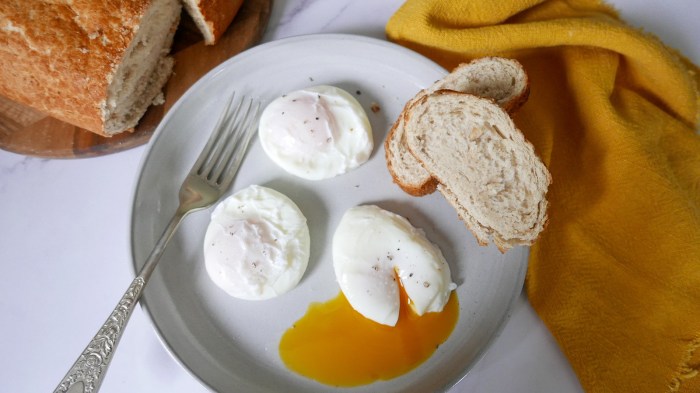
Sous vide poaching eggs is a technique that requires precision and attention to detail, and while it’s generally straightforward, there are some common issues that can arise. This section will address these challenges and provide solutions for achieving perfect results every time.
Troubleshooting Common Problems
Sous vide poaching eggs, despite its ease, can present some challenges. This section will explore common problems and offer solutions to ensure perfect results.
- Overcooked Yolks: Overcooked yolks are a common issue when poaching eggs sous vide. This typically happens when the eggs are cooked for too long or at a temperature that is too high. The yolk will become firm and rubbery, losing its desirable creamy texture.
To prevent this, ensure you adhere to the recommended cooking time and temperature for the desired doneness.
- Undercooked Yolks: While overcooked yolks are common, undercooked yolks are another potential problem. This happens when the eggs are not cooked long enough or at a low temperature. The yolk will remain runny, which might not be desirable for all applications.
Ensure that you cook the eggs for the appropriate duration at the right temperature to achieve the desired level of doneness.
- Uneven Cooking: Sometimes, eggs may cook unevenly, resulting in parts of the yolk being cooked more than others. This can happen due to variations in the water temperature or the eggs being crowded in the bath. To avoid this, ensure the water bath is evenly heated and that the eggs are not overcrowded.
- Eggs Sticking to the Container: Eggs can stick to the container if they are not properly sealed or if the container is not properly cleaned. This can make it difficult to remove the eggs from the bath. To prevent this, use a food-grade silicone pouch or wrap the eggs in plastic wrap before immersing them in the bath.
Tips for Achieving Perfect Results
Here are some valuable tips for ensuring perfect sous vide poached eggs:
- Use Fresh Eggs: Fresh eggs are essential for sous vide poaching. Older eggs tend to have thinner whites, making them more prone to breaking during the poaching process.
- Crack Eggs Carefully: When cracking the eggs, avoid breaking the yolk, as this can affect the texture and appearance of the poached egg. Crack the eggs into a small bowl or ramekin before transferring them to the pouch or container.
- Season the Water Bath: Adding salt and vinegar to the water bath can help prevent the whites from spreading too much and can improve the texture of the poached eggs.
- Remove Eggs Gently: Once the eggs are cooked, remove them from the bath gently using a slotted spoon or a pair of tongs. Avoid squeezing the eggs, as this can damage the yolk.
- Serve Immediately: For the best results, serve the poached eggs immediately after cooking. If you need to store them, refrigerate them in an airtight container for up to two days.



